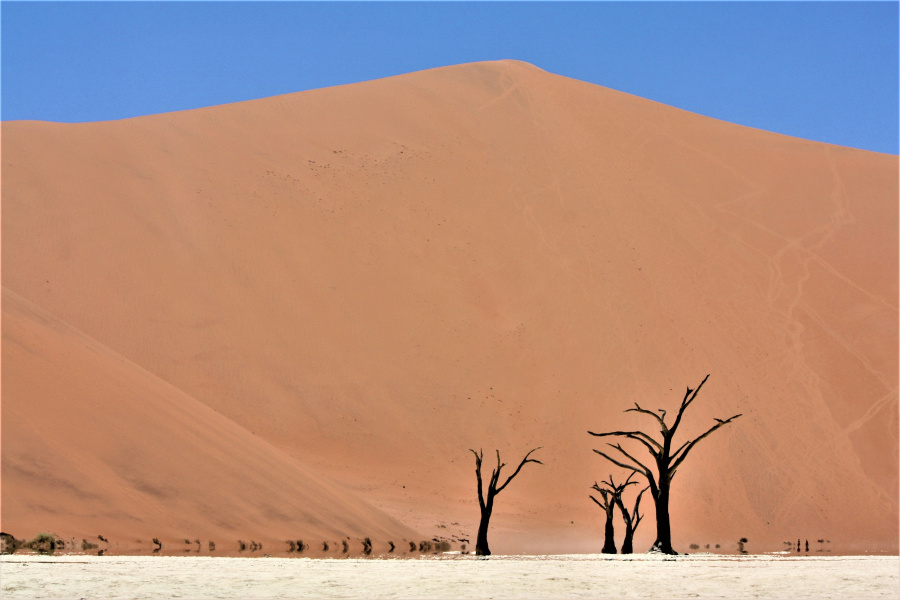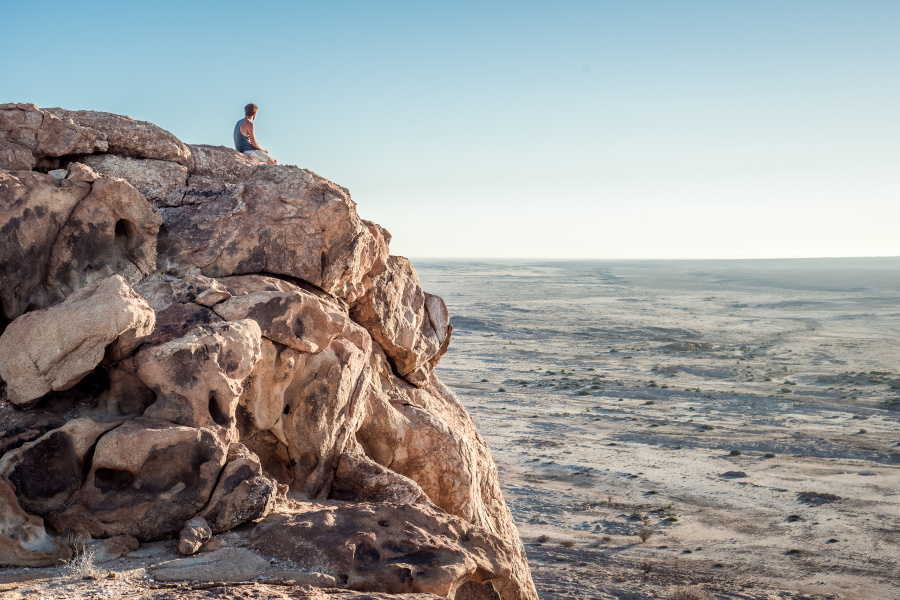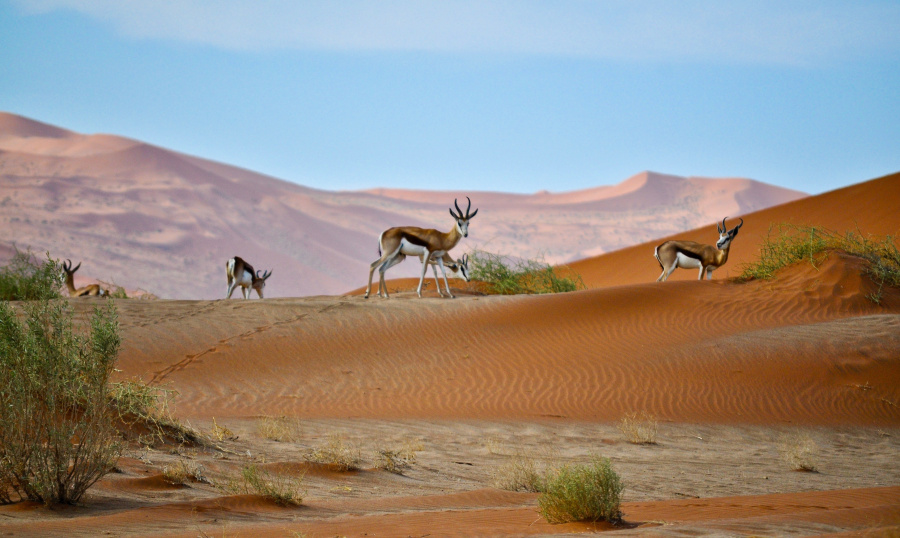Since Namibia has one of the most uninviting and desolate coastlines in the world, it was neglected by European explorers like the Portuguese, who limited their activities to setting up navigational crosses along the desert shoreline. Today visitors have discovered the vast potential of a country rich in natural resources, with desert landscapes, sunshine, wildlife and a rugged, barren beauty.
Namibia has a diversity of natural habitats: the rugged coastline and haunting beauty of the Skeleton Coast, the endless stretch of undulating ochre-coloured sand dunes at Sossusvlei, the impressive gorge of the Fish River Canyon winding through the arid landscape of the great plateau, and the vast salt pan of Etosha National Park, one of the world's greatest wildlife viewing destinations. These are the attractions that draw travellers to one of Africa's more intriguing destinations, the unspoilt wilderness of Namibia.
With a total population of just over two million, a holiday in Namibia is the opportunity of a lifetime to experience the beauty of a pristine natural environment teeming with wildlife.
Namibia is one of the best places in the world to visit if you have a hankering for a stunning variety of dramatic desert landscapes, and the country's most popular attractions are things like salt pans, sand dunes, rock formations and clay pans, which form the beautiful but harsh backdrop for wildlife safaris and a wealth of ancient rock art.
Travel in Namibia is a celebration of open spaces and silence, and the country is a photographer's dream. The formidable coastline of the Namib Desert is one of the most popular areas to explore, with tourists most commonly choosing to stay at Walvis Bay and the charming Swakopmund, and enjoying excursions to desert gems like Sossusvlei and the Spitzkoppe Mountains.
Windhoek, the capital city, is also a great base for travel, with a number of urban attractions and potential for excursions further afield. The best places to see San (Bushmen) rock art are Twyfelfontein and Brandberg, although the ancient carvings and paintings are wonderfully common. Etosha National Park is a delight for game viewing and the Fish River Canyon is a magnificent and challenging place to hike. Popular activities in Namibia include wildlife safaris, surfing, scuba diving, dune boarding, fishing, golf and boating.

Walvis Bay
Visitors to Walvis Bay are spoilt for choice when it comes to sightseeing options. 4x4 trips to Sandwich Bay offer visitors the opportunity to see some of the desert's most unique and rare wildlife as well as amazing photo opportunities. Dune boarding is a must for the adventurous and fishing, diving and dolphin viewing excursions are fantastic opportunities to see the wealth of sea life Walvis has on offer. Evenings are best spend sipping a cocktail or ice cold beer while watching the flamingoes sift through the waters of the lagoon.
Etosha National Park
Etosha National Park, the 'great white place of dry water', is a vast area of shimmering mirages and saline desert, savannah and scrubby woodlands, situated 270 miles (435km) north of Windhoek. Its unique landscape is characterized by an immense, flat white saltpan, a shallow depression that is dry for the greater part of the year, but fed by moisture from perennial springs on the fringes. The pan covers about 25 percent of the park.
The Namib Desert
The Namib Desert boasts the dauntingly desolate landscapes of the Skeleton Coast, some of the biggest sand dunes in the world, some uniquely adapted desert wildlife, and a number of breathtaking natural attractions. Highlights of the Skeleton Coast National Park include the Agate Mountain salt pans, the clay castles of Hoarasib, and the Cape Fur Seal colony at Cape Fria. The clay pans and huge orange sand dunes of Soussusvlei are among Namibia's most famous tourist attractions and a must-see in the Namib Desert.
WIndhoek
A little bit of Germany in Africa, a holiday in Windhoek, capital of Namibia, is flavoured with traditional brews, sausage and sauerkraut to complement its lovely colonial architecture. Travel to Windhoek, though, and you will also find a good ethnic mix of colourful African culture that will leave you in no doubt that you are in the commercial heart of a vast southern African country. Most of those who travel to Windhoek, Namibia's main point of entry by air, come to use it as a jumping off point for a safari trip or desert expedition, spending a few days on holiday in Windhoek at the beginning or end of their journey to get to know the city.
Fish River Canyon
Widely regarded as the second largest canyon in the world, after the USA's Grand Canyon, the Fish River Canyon is located in southern Namibia in the eastern Namib Desert. The 100-mile (161km) long canyon was created by a fracture in the earth's crust and then further carved by the erosion of the Fish River over millions of years. The main attraction of the area is hiking, but hiking the Fish River Canyon can only be undertaken during the winter months, and requires a high level of fitness and good health; there are no facilities whatsoever, so hikers must carry all they need. T

General weather conditions: Namibia's climate is generally hot and dry. Summer is very hot and the Namib Desert should be avoided at this time as temperatures are often above 104ºF (40ºC) and extremely uncomfortable. The coast is cooler and often foggy in summer. Average winter temperatures during the day range between 64°F (18°C) and 71°F (22°C) and the days are pleasantly warm and sunny, but the nights can be very cold, especially in the desert, with frost covering the ground in the mornings, so be sure to bring warm things.
Best time to visit: The best time to visit is during the winter months from March to October: April and May are green and fresh months in Namibia; June and August are the best for game viewing as animals tend to congregate around waterholes, making them easy to spot; September and October are also fantastic for game viewing but it can be very dry and dusty.
Rainy season: Rainfall occurs exclusively in the summer months, between November and February, when some humidity and heavy thunderstorms can be expected. Even during the rainy season thunderstorms tend to be localised and occur more in the centre and east of the country, while the desert receives markedly less rain.
All foreign passengers to Namibia must have confirmed return/onward tickets, and the necessary travel documentation for their next destination. Additionally, visitors should ensure that they have at least two blank pages remaining in their passports, for entry and departure endorsements from the Namibian Immigration Service. Note that a yellow fever vaccination certificate is required to enter Namibia, if arriving within six days of leaving or transiting through an infected area. All travellers must have a passport that is valid for at least six months beyond the period of intended stay in Namibia.

Health
Typhoid, hepatitis A and hepatitis B vaccinations are recommended for travel to Namibia. Safety regulations in Namibia require all visitors to have a yellow fever certificate if arriving from an infected area. There is a malaria risk in the northern region of Namibia during the rainy season (January to April). HIV/AIDS is prevalent and precautions are essential, although travellers are seldom at risk unless engaging in unprotected sex with locals. Cholera outbreaks do occur and visitors should drink only boiled or bottled water, and avoid ice in drinks. There has been an increase in the incidence of rabies among dogs in Windhoek; travellers at risk of animal bites should consider a rabies vaccination. There are good medical facilities in Windhoek, but medical insurance is essential as treatment is expensive. Outside of the main cities medical treatment may be hard to come by. Travellers to Namibia should take medical advice at least four weeks prior to departure. For peace of mind it is best to take prescription medications along when travelling; medicines should be kept in their original packaging and accompanied by a signed and dated letter from a doctor detailing why the medication is needed.
Business
Business in Namibia is conducted somewhat formally, although drinking and socialising are an important part of building good working relationships. Standard business etiquette applies; dress tends to be formal with more lightweight materials worn in the hotter seasons, punctuality is important, shake hands on greeting and leaving and in general be polite and professional. English is the language of business, though German and Afrikaans are widely spoken. Business hours are usually 9am to 5pm Monday to Friday.
Duty Free
Travellers to Namibia over 16 years do not have to pay duty on 400 cigarettes, 50 cigars and 250g of tobacco; 2 litres wine and 1 litre spirits or liquor; 50ml perfume and 250ml of eau de toilette; and gifts to the value of N$50,000.
Communications
The international access code for Namibia is +264. The outgoing code is 00 followed by the relevant country code (e.g. 0027 for South Africa). City/area codes are in use, e.g. (0)61 for Windhoek. Most towns are covered by a GSM 900/1800 mobile network. Internet access is available from some hotels and Internet cafes are available in Windhoek and Walvis Bay.
Electricity
Electrical current is 220 volts, 50Hz. Round three-pin plugs are standard.
Language
English is the official language, but many people also speak Afrikaans and German. There are also several indigenous languages spoken, mainly in the rural areas.
Money
The official currency is the Namibian Dollar (NAD) divided into 100 cents. Its value is equal to the South African Rand, which is also accepted as legal currency in Namibia. Major credit cards are accepted. Foreign currency can be exchanged at any bank or bureau de change. ATMs are available in larger towns only.
Emergencies
In most of the country 1011 is the emergency number for police.
Safety
The majority of visits to Namibia are safe and trouble-free, but beware of increasing street crime and pick-pockets in Windhoek and other town centres. Theft from vehicles, especially from service stations, is common and valuables should be kept out of sight and the car locked. Avoid using taxis if possible and never take one alone. Care should be taken when travelling in the Caprivi Strip; travel in daylight hours only (livestock wandering onto roads at night cause many accidents), and stay on the main tarred highway as there is a risk of landmines remaining from the Angolan civil war. Namibia is considered at very low risk of terrorism, and there have been no major incidents reported of violence against foreigners. Travellers should carry identification such as photocopies of their passport at all times.
Customs
It is best to check before taking pictures of State House or properties where the President is residing, as well as any buildings guarded by the army or police.
Tipping
Tips of 10 percent are expected where a service charge has not been included in the bill. Tour guides, game rangers and trackers rely on tips for their income and should be tipped accordingly.